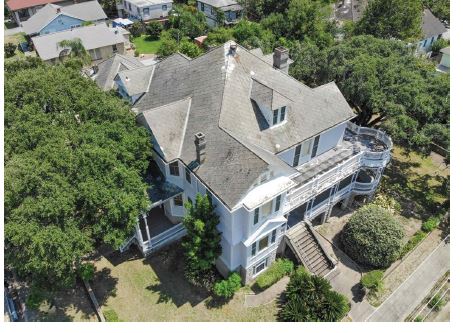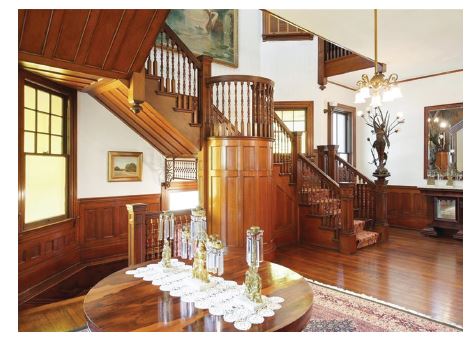Not all of Galveston’s impressive mansions can be found along Broadway. Taking time to explore the streets off the main thoroughfare reveals a number of remarkable homes with marvelous histories.
The enchanting Queen Anne at 1804 35th Street, on the southeast corner of Avenue O ½ Street, is known as the Pauls Chuoke House after two families who lived there for decades. The home’s first resident, however, was Felix Emile Mistrot (1860-1936) who built the house with his wife Eva Wilson (1865-1942) and moved in 1899.
Mistrot and many of his brothers followed in the footsteps of their father, who immigrated from France to Louisiana to open his own mercantile.
In 1880, Felix worked as a clerk in his brother Charles’ (1854-1933) store in Johnson County, Texas. He met young Eva during that time, and they were married three years later.
The young couple moved to Waco, where Felix worked briefly as a traveling salesman for Sanger Brothers before moving to Bryan to open his own large store in 1886. He thrived as a business owner and gained a patent for “knock-down” glass and metal showcases in his stores, which could be moved around the floor and had adjustable shelves.
In 1896, they relocated to Galveston with their four young children, and Felix partnered with two other brothers, Simeon Pierre (1854-1924) and Gustave Antoine (1862-1937), in operating Mistrot Bros. & Co., which sold dry goods, notions, clothing, furnishing goods, boots, shoes, hats, and other items. Their store was located at 2310-2328 Mechanic Street in the building that is now home to the Tremont House.
 The family soon saw financial success and increased social standing and was able to build a home that properly reflected their position.
The family soon saw financial success and increased social standing and was able to build a home that properly reflected their position.
Every inch of the slate- and metal-roofed house reflected the couple’s exquisite French Art Nouveau style. The impressive exterior incorporated five porches, including two wrap-around porches on the first and second floors, with walk-through windows that allowed access as well as invited breezes to cool the home. A porte cochere on the left side of the home allowed a covered entrance for vehicles and carriages.
As guests walked through the gates past the gracious grounds, they were greeted by an impressive entryway that led to a spacious reception hall. The grand staircase featured a bronze statue upon the newell post, and a Juliet balcony landing that provided a picturesque opportunity for splendid entrances by the ladies of the house.
Designed with ten rooms and two baths, the house showcased large living areas for entertaining, hardwood floors, five fireplaces (two of which were flanked by hand-carved Griffins), 13 closets, two pantries, a floored attic, and gas and electricity.
The insurance papers for the home were dated December 2, 1899, just nine months before the 1900 Storm.
Though the home survived this historic hurricane, it did need a good amount of repair that required 30 days to complete, in addition to having the home raised during the island grade raising. During this time, Eva and the children stayed in Bryan with her parents while Felix tended to the restoration of the house and his business.
According to insurance documents and photographs of the home taken before and after the storm, Felix also took advantage of the opportunity to add a rounded corner feature to the upper and lower porches, masonry arches to the ground floor, and “gasoline powered machines” to one of the small back buildings.
The Mistrot family enjoyed their updated home until they moved from the island, selling the house to Peter George Pauls (1856-1943) in 1906.
 Pauls, who immigrated from Germany at the age of 15, moved from his home at 1717 Postoffice Street into the larger home, bringing his wife Caroline “Carrie” W. Cortes (1863-1931), their five children, and a Scotch collie named Taffy. His wife was the daughter of German immigrants as well, so it is likely that German was spoken in the home, as it was in numerous Galveston homes of that era.
Pauls, who immigrated from Germany at the age of 15, moved from his home at 1717 Postoffice Street into the larger home, bringing his wife Caroline “Carrie” W. Cortes (1863-1931), their five children, and a Scotch collie named Taffy. His wife was the daughter of German immigrants as well, so it is likely that German was spoken in the home, as it was in numerous Galveston homes of that era.
Pauls was a cotton buyer whose office was at the magnificent Cotton Exchange building. The social events hosted by the Pauls in their new home no doubt included many business acquaintances and provided opportunities for their children to meet members of other successful families in the community. All five offspring were married while the Pauls lived in the house on 35th Street.
Their daughter Myrtle (1891-1923), who was considered one of the great beauties of Galveston, married car dealer Harry Ewing Stewart (1893-1975) in 1914. Her father arranged for a business opportunity for the young man that entailed the couple moving north off of the island.
Myrtle unfortunately died of a brain hemorrhage nine years later leaving Stewart and their son behind. Stewart rebounded by marrying wealthy Houstonian widow Mellie Brown Esperson.
The Pauls’ son Cortes (1894-1958) married Katharine Vedder (1893-1975) in 1916. Her father was prominent cotton factor Charles Adam Vedder (1861-1925).
After returning from finishing school in the east, daughter Lillian (1889-1981) married attorney Veris E. McInnis (1880-1968) in 1920.
Waldo Robert “Duck” Pauls (1896-1988) married Gertrude Mensing (1905-1988) in 1929. Her father Gustave Henry Mensing (1873-1961), along with his brother, owned Mensing Bros. & Co. wholesale grocers, importers, and cotton factors on The Strand.
In 1934, youngest son Louis Edward “Chick” Pauls, Sr. (1904-1983) married Eleanor B. Harriss (1913-1953). Her father, who had passed away by the time they were married, was Baylis Earl Harriss (1883-1926) who had been president of one of the largest cotton merchandising firms in the country, and one-time mayor of Galveston.
Carrie, the matriarch of the Pauls family, passed away in 1931 and her husband Peter died a dozen years later in 1943. Both of their funeral visitations were held at their home. Waldo and his wife and son lived with his dad Peter in the house on 35th Street at the time of his death.
Waldo soon moved his family to Houston and rented the home on 35th Street. During World War II, there were numerous servicemen and their families looking for housing on the island.
One such couple was Lettie Faye Clawson and Sergeant LaVern Gilbert Leverington, Sr. who were married in February 1945 at the Galveston Army Airfield chapel. After their wedding trip, they moved into the home and the young man returned to his assignment at the radio operator’s school. It’s likely that they shared the house with several other renters.
The next chapter in the home’s history involved a family that was equally active in the community. Robert “Bob” C. Chuoke, Sr. (1906-1979) and his wife Mary Lee Ranieri (1909-2002) purchased the large house and moved there with their teenaged son in 1946.
Chuoke began his successful plumbing business in a small frame building in 1924, and by the time they moved into the home, he had begun serving his first of 10 years as the Galveston Water and Sewage Commissioner (1945-49, 1955-61).
By the end of his first term as commissioner, he was able to build a large new structure for Chuoke Plumbing at 40th Street and Broadway, the building that is now occupied by Bayside Chic.
The entrepreneur also served as president of the influential Sunday Morning Coffee Club. The club included a cross section of island businessmen who regularly gathered to discuss problems of Galveston and propose solutions. Because of the prominence of members, many were in a position to take action on the issues.
Chuoke’s proudest accomplishment was the establishment of a pension plan for city employees of Galveston.
Mary held meetings of the Morning Glory group of the Galveston Garden Club in their home throughout the 50s and 60s.
Their son Robert Jr., a graduate of Ball High School, was drafted by the Detroit Lions in 1956 and played one year for the Toronto Beachers.
After her husband’s passing, Mary sold the grand home. Though the following owners have made some changes to the home over the years, including decreasing the number of fireplaces and increasing the number of rooms, the residence miraculously retains chandeliers, sconces, fireplaces, art work, and pieces of furniture that are original to the home.
Today the lovely home serves as a reminder not only of Galveston’s diverse architecture, but of how the people who lived in these homes tied in to numerous formative eras in island history.